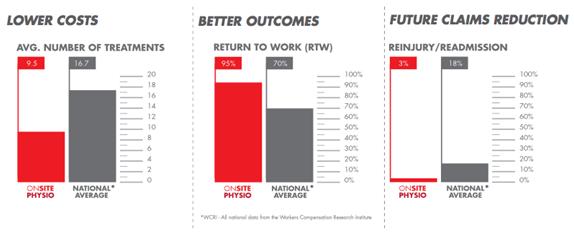
In order to improve your return-to-work rates, you must first instill a program designed to do so. By implementing an on-site physical therapy protocol to your current workers’ comp program, you can increase your programs return-to-work rates and thus lower workers’ comp costs.PhysNet has developed a powerful industrial athlete rehab protocol, which elicits the best results for the worker and the employer. It consists of:
Our specialized plan of care provides contemporary, cutting-edge, functional treatment. Our "show me what you do" versus "tell me what you do" means the specialized plan of care will match the return-to-work goals. Our physical therapist will observe an employee’s:
e.g. An employee has injured her shoulder flipping mattresses. Now it is time to simulate her work with her. Exercises specific to her body size, strength, and the work environment which enable her to perform that task, without physical harm to herself will be used. Her treatment is directly transferrable to the workplace. Exercises are natural movements she uses in real life (i.e. they’re “functional”). The purpose is to strengthen her muscles and create muscle memory to reduce any chances for future reinjury.
A PhysNet physical therapist comes to deeply understand the physical movements required of the job functions which make your business work. Your therapist specializes in the injuries associated with your business and is a keen, trained scientific observer and diagnostician. Within moments, he or she can see how a worker is straining his or her body unnecessarily.
Our physical therapists schedule the appointments according to the worker's/employer's schedule. The treatment plan is now followed with a great degree of compliance because there is so little disruption to the workday. When therapy treatment sessions are frequent, close together, and on-target, your injured worker is able to get better faster.
You’ve likely seen this in regular fitness programs. Think about how dramatically different results are when you go to the gym three times a week for four weeks and you do exactly what you should to meet your specific fitness goals as opposed to going once a week for 12 weeks and doing a mish-mash of exercises.
As the workers’ compensation expert and the injured worker's supervisor, you get updates of the return-to-work status of the injured worker from the person treating the worker. This enables you to:
The therapist who treats your employees on-site is the same from one injured employee to the next. So when he or she comes to your facility to treat a subsequently injured worker, he or she can check back in with prior patients to monitor activity and fine-tune ergonomics, so future injuries are prevented.
What to expect from this type of program
By implementing these steps and having on-site physical therapists you create a focus on conditioning your workers’ bodies. As a result, your workers absorb the correct muscle memory for performing the specific tasks of their jobs, which reduces the potential for future injuries.
Using the PhysNet Industrial Athlete Rehab Protocol can deliver results similar to these:
And at the same time, this type of program can decrease the costs you incur from:
Take control of your worker’s comp claims by implementing a program designed to improve your return to work rate while reducing reinjury rates. Many say if it isn’t broke, then don’t fix it, but here at PhysNet we believe that if it isn’t broke, then we have a great starting point to make it more efficient and effective. Let us show you how you can implement this protocol to improve your program today!
Locate one of our nationwide OnSite Physio therapists now.
PO BOX 160070
Altamonte Springs, Fl 32716
referrals@physnet.com
Phone: 866-907-4797
CONTACT US|
©2021 PhysNet, LLC. All Rights Reserved.
|
 |